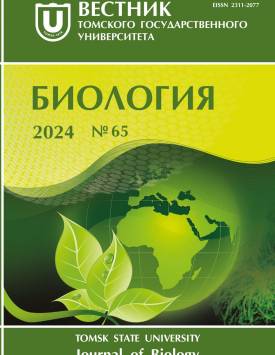Brown bear marking objects on the Eastern Sakhalin
Marking activity is important for intraspecific communication of carnivorans, and brown bear (Ursus arctos L.), in particular. Marking, together with olfactory and visual signals, contribute to the spatial distribution of individuals, reduces the likelihood of unwanted encounters with representatives of same and other species, informs about the social status of individuals, facilitates the meeting of sexual partners during the rut, and accomplish the functions of territorial protection. Bears mainly choose trees as marking objects. To study brown bear communication system is important for understanding natural population processes whose disruption caused by human activities requires targeted conservation measures. The study site was located in the Vostochny Reserve on the eastern coast of Sakhalin Island (50°30'-50°42N, 143°33'-143°42'E) in 2010-2012. The study area is characterized by mountainous relief with dark coniferous taiga as the dominant plant formation. We described 218 bear marking trees along routes in the basins of the Vengeri and Pursh-Pursh rivers and registered tree species and its trunk diameter, forest type, and terrain. To compare marking trees with unmarked, but available for bears' marking, we described all unmarked trees (n = 1479) within a 10 m radius from the marking trees, indicating their species and diameter. We registered and measured fresh (of the current year) and old signal marks on the trees: rubbing sings, debarking, and bear bites (See Fig. 1) and scratches. Brown bear pedal marks near marking trees were also registered. We found five species of trees marked by brown bears: Sakhalin fir (Abies sachalinensis F. Schmidt) Mast.) (See Fig. 2), Ayan spruce (Picea ajanensis (Scibold & Zucc.) Carriere), Cajander larch (Larix cajanderi Mayr), goat willow (Salix caprea L.), and Erman's birch (Betula ermanii Cham.). Most of the marking trees were Sakhalin fir (84.4% of all marking trees), which, according to the selection analysis were the only species preferred by bears (Jacobs' index = 0.23; see Fig. 3). Brown bears preferred to mark trees with a larger trunk diameter than available in the environment (average 29 and 25 cm, respectively; W = 191904; p < 0.001; see Table 1). Among the marking trees 90% were alive. Among the fresh marking signs on a marking trees rubbing signs were the most often (45.4%) and located at a height of 20 to 268 cm. The debarking of the current year was registered on 7.8% of marking trees, and the maximum damage height was 341 cm. Fresh bear claw scratches were on 35.2% of the marking trees. The average upper limit of scratches was 222.9 cm, with a maximum of 390 cm. Fresh bear bites were on 13.8% of the tree trunks, ranging up to a height of 321 cm. Many marking trees are permanent for bears and used annually; some of those are used most intensively. Repeated marking of the same objects by different individuals over a long period of time makes them communication centers of brown bears at the population level. We found bear pedal marks (depressions in the ground left by the bear's paws) around nine trees. They comprised 5-25 holes from paw prints. The nature of the marking signs left by the bears had similar features to those in the other parts of the species' area. Most of the marking trees (89.4%) were located in the floodplains and on the terraces, the rest were on the slopes of different exposure. Bears marked trees in the forests dominated by Sakhalin fir (73.9%), less often with dominance of Cajander larch (12.5%), Erman's birch (7.4%), Ayan spruce (5.1 %), and in floodplain deciduous forests (1.1%). The vast majority of marking trees were located on bear trails (210 trees, 96.3%). The location of marking trees along the trails increases the effectiveness of trees involved in animals' communication activities, facilitating their detection. The marking complexes included two trees (27 times), three trees (10 times), four trees (5 times), five trees (2 times), and six and seven trees (1 time). The linear frequency of tree marking by bears on forest trails was 3.2 trees per 1 km. Such density of marked objects is relatively high, which is due to the relatively low anthropogenic pressure on the Reserve territory. The relative density of marking trees varies from site to site and depends on the bears number, the availability of trees suitable for marking, trails, anthropogenic pressure, and other factors. The frequency of tree-marking is a parameter that can be successfully used in determining the relative population density of brown bear and monitoring of its population state. The paper contains 3 Figures, 1 Tables, 33 References. The Author declares no conflict of interest.
Keywords
animal dendroactivity, marking tree, population, pedal marking, Ursus arctosAuthors
| Name | Organization | |
| Seryodkin Ivan V. | Pacific Geographical Institute, Far Eastern Branch of the Russian Academy of Science | seryodkinivan@inbox.ru |
References

Brown bear marking objects on the Eastern Sakhalin | Vestnik Tomskogo gosudarstvennogo universiteta. Biologiya - Tomsk State University Journal of Biology. 2024. № 65. DOI: 10.17223/19988591/65/9
